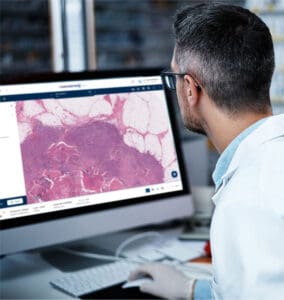
[Concentriq digital pathology software image courtesy of Proscia]
Adoption has grown from a negligible amount to roughly 15% over the past five years, said David West, CEO of Proscia, a digital pathology company, and a Q2 Solutions partner. The Digital Pathology Association notes that adoption in recent years has been brisk, hovering between 27% and 37% growth from 2021 to 2023, with the pandemic serving as an accelerant. Growth is cooling but is still brisk. According to Proscia’s 2023 Life Sciences Digital Pathology Adoption Survey, 70% of life sciences organizations were using digital pathology, with an additional 53% of those not yet adopting planning to implement it by the end of that year. The study involved 40 executives in the life sciences sector, including CROs and top pharma firms.
Digital pathology’s impact on clinical trials
The implications for clinical trials are significant given that digital pathology can enable centralized slide review and standardized training. Traditionally, “a significant focus of digital pathology has been on primary diagnosis and routine diagnostic work, as well as early-stage discovery research,” West said. Going digital opens up “new frontiers” of improved efficiency, standardization, and accuracy, Lamba Saini said.

David West
The benefits are multidimensional. Digital pathology enables more precise evaluation of patients into clinical studies. For pathologists, it promises enhanced workflow efficiency and standardized interpretations that are reproducible across different pathologists and centers.
“This standardization aids in patient enrollment in clinical trials, stratification, randomization into treatment arms, and endpoint evaluation,” Lamba Saini said. Additionally, integrated data analysis tools in the context of digital pathology can translate into clinical trials that are not only more efficient, but more accurate as well. Modern digital pathology platforms can also streamline toxicopathology workflows, facilitating efficient management of study protocols and real-time evaluation of results, improving reliability and analysis productivity in clinical trials.
Breaking down the pathology tower of Babel
The digitization of pathology data promises to improve collaboration by breaking down longstanding barriers. Traditionally, chemists, biochemists, and other scientists work closely with pathologists to interpret lab tests, guide patient care, and research diseases. Yet siloed tools and formats can hamper data sharing. As Michael Connell of Enthought notes, different specialists “have a piece of the puzzle, but they don’t necessarily speak each other’s language.”

Michael Connell
While platforms linking de-identified data may enable valuable applications like biomarker discovery, the core challenge remains bridging the fragmented languages and perspectives still hampering seamless collaboration between specialties. Technical tools alone cannot decode the “Tower of Babel problem,” as Connell put it. The key is viewing data as a product that can enable human communication and understanding while furthering scientific research.
Merging data streams opens up new possibilities
There are signs of progress in this regard. Proscia, for instance, can link de-identified real-world patient data from digital pathology platforms to support biomarker discovery and companion diagnostic development. As West explained, Proscia’s platform captures diverse data types beyond just pathology images, including molecular data, treatment history, and clinical notes. By partnering with data linking services like Datavant and Health Verity, this patient data can be de-identified and connected with data from other systems to “complete the patient record.”
West highlighted the value of this linked real-world data for precision medicine applications. In areas like immuno-oncology, treatments target small subsets of patients, making it difficult for pathologists to visually assess candidacy. “You need image-based and AI tools,” he said. The data can also improve patient identification and matching for clinical trials enrollment. “We should know if a patient is a candidate for a trial as soon as their biopsy hits the pathologist’s desk,” West noted.

Dr. Monika Lamba Saini
According to Proscia’s 2023 Life Sciences Digital Pathology Adoption Survey, eight out of ten (82%) organizations using digital pathology in 2023 were also implementing AI applications, mainly for automated image analysis and workflow optimization. The respondents noted that such AI systems helped bolster efficiency and quality control while facilitating the discovery of novel biological insights.
In addition, laboratories, digital pathology vendors and AI vendors are emerging that can help with “quantifying data or extracting molecular or biomarker data from routinely stained hematoxylin and eosin sections,” Lamba Saini said. Hematoxylin and eosin (H&E) is the most common stain used in pathology to examine tissue samples under a microscope. The possibility of extracting additional biomarker data from these routine H&E slides without needing special stains could speed research and expand treatment options for patients.
A pathology ‘co-pilot’
In the short term, one of the biggest promises for digital pathology is addressing the shortage of pathologists that is common in many parts of the world. A 2021 study found Germany, for instance, had 1 pathologist per 47,989 inhabitants. An article from the American College of Pathologists noted there is a perceived shortage of pathologists in the U.S. as well, leading to a need to draw inspiration from lean methodology, robotics and automation to boost efficiency.
Data sourced from the "2023 Life Sciences Digital Pathology Adoption Survey" by Proscia.
In the software world, generative AI tools have emerged to serve as a “co-pilot” for coders, helping to improve efficiency and automate repetitive tasks. Similarly, with digital pathology, software and apps can act as companions or adjuncts to pathologists, Lamba Saini said. “These tools are particularly useful for monotonous tasks such as examining mitoses or counting them, which are crucial for cancer grading,” she said. For example, in breast cancer grading, software can help handle such tasks in a more reproducible and standardized manner compared to manual processes by pathologists. “This is important because in monotonous tasks like counting mitoses or quantifying them, the inter-pathologist reproducibility or concordance can vary,” Lamba Saini said. Thus, AI algorithms that focus on such quantifiable and repetitive tasks are “incredibly valuable in ensuring consistency and accuracy in diagnosis,” she said.
The addition of AI and image analysis to digital pathology allows for the quantification of certain pathological parameters. “That quantification helps in patient entry into clinical trials,” Lamba Saini said. Having standardized quantifiable measurements enables improved patient enrollment, stratification, and randomization into clinical trial treatment arms. It also facilitates more objective and reproducible analysis of clinical trial endpoints.
The power of decentralization
As the momentum builds, the capabilities of digital platforms are set to continue improving, offering progressively more powerful image analysis, data integration, and collaboration among pathologists. “With digitization, slides can be viewed on laptops, computer screens, or even mobile devices,” Lamba Saini said. Conversely, traditional pathologists had to physically be present in labs, relying on direct, manual examination of glass slides. Added to that was the task of retrieving glass slides from storage was a huge task. Cloud-based digital pathology significantly streamlines archival and retrieval.
Digitization also enables broader slide access for clinical trials. It facilitates pathologists “remotely” assessing slides while “allowing specialists to review and offer opinions,” thereby enhancing diagnostic standardization. Lamba Saini notes particular interest in quantifying immune pathology biomarkers like PD-L1, which are “crucial for treatments with checkpoint inhibitors.” However, “reproducibility in quantifying these biomarkers has been challenging.” She explains that new “image-guided software and algorithms” are overcoming these hurdles and gaining regulatory approval.
Extracting more value from routine slides
In addition, Lamba Saini highlights emerging efforts to use routine stained slides to extract molecular data, potentially “eliminating the need for specific immune or molecular analyses.” Virtual slide generation could also lead to flexible multiplexed imaging. She explains that while past algorithm limitations required substantial labeled datasets, “we’re entering an era of generative AI and foundation models” that tap huge datasets for specialized fine-tuning.
Digital pathology does represent a significant investment for labs and medical facilities. The upfront costs of purchasing and implementing a comprehensive digital pathology system can be substantial, often running into six figures, with additional ongoing expenses for system maintenance, data storage, staff training, and IT support. However, over a period of several years, the potential benefits and long-term cost savings enabled by digital pathology can offset a portion of these initial capital costs. The recent approval of digital pathology for cancer screening in the U.K. underscores this technology’s potential in medical diagnosis and research. as demonstrated by a study the University of Warwick and University Hospitals Coventry and Warwickshire (UHCW) recently conducted. The enhanced efficiency, standardization, and precision unlocked by digital pathology and AI tools propel clinical trials to new heights of productivity and accuracy – helping transform clinical trial information from slide storage dust to data insights.
Filed Under: clinical trials, Data science, Drug Discovery, machine learning and AI



